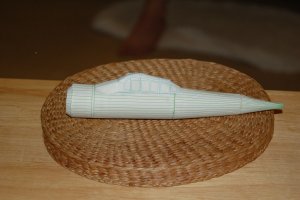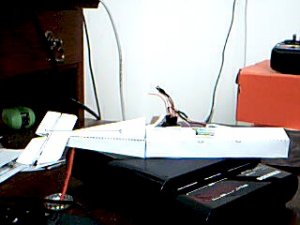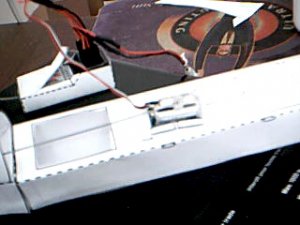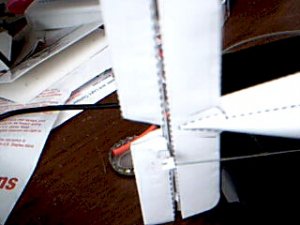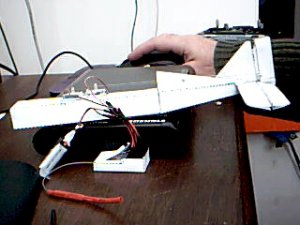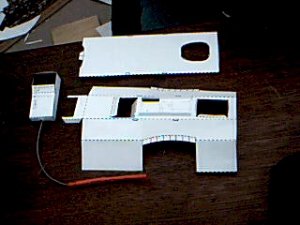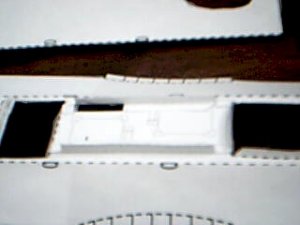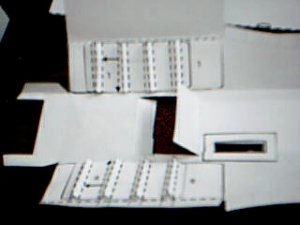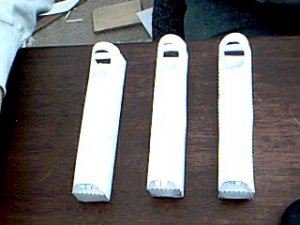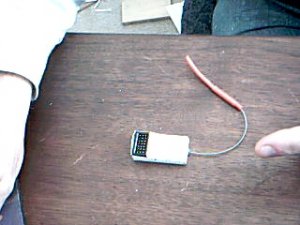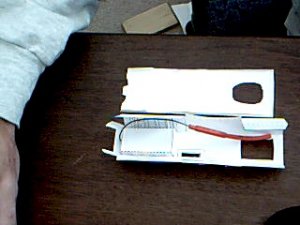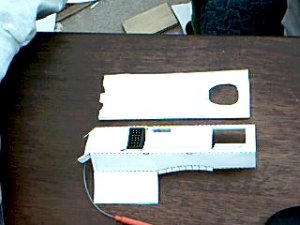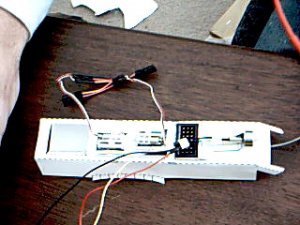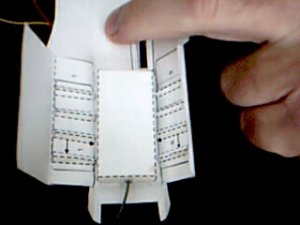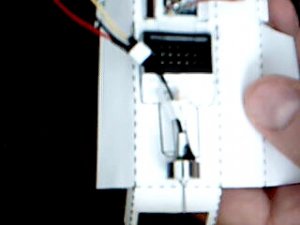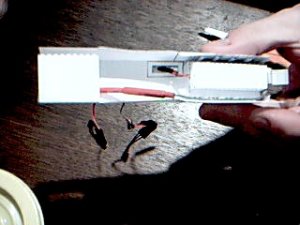Need advice about RC options for ultralight paper airframe project
- Thread starter liftline
- Start date
You are using an out of date browser. It may not display this or other websites correctly.
You should upgrade or use an alternative browser.
You should upgrade or use an alternative browser.
Yeah, a nice payoff indeed!
I went to a local college stadium to use the track last night and there was an electric indoor fly in going on 4 stories down in the main arena. Mostly ready to fly (So many piper cubs & mustangs) and even more slab sided foamies. Fair number of ready to fly helis - but no quad copters. Met some good people, checked out what they were doing and how. Geared inrunner motors dominated.
Now that I know the 2 gram motor is viable my next step is to lengthen the very short motor leads (after carefully labeling everything ;-)) and solder every thing nicely.
After that, start building the first X plane...or maybe I should call it a Y plane 'cause it is intended to be a "production" design. I'm leaning to just trying it out with rudder and elevator. A bit quicker to build, a bit lighter, and I would feel more comfortable flying a very simple system for starters. Rest assured the goal is still 3-axis control.
Looking down the road a few months - hmmm a 5 g motor in a AM2 Zero would be pretty slick! Just happen to have a zero design from 2 years ago in my files!:idea:
I went to a local college stadium to use the track last night and there was an electric indoor fly in going on 4 stories down in the main arena. Mostly ready to fly (So many piper cubs & mustangs) and even more slab sided foamies. Fair number of ready to fly helis - but no quad copters. Met some good people, checked out what they were doing and how. Geared inrunner motors dominated.
Now that I know the 2 gram motor is viable my next step is to lengthen the very short motor leads (after carefully labeling everything ;-)) and solder every thing nicely.
After that, start building the first X plane...or maybe I should call it a Y plane 'cause it is intended to be a "production" design. I'm leaning to just trying it out with rudder and elevator. A bit quicker to build, a bit lighter, and I would feel more comfortable flying a very simple system for starters. Rest assured the goal is still 3-axis control.
Looking down the road a few months - hmmm a 5 g motor in a AM2 Zero would be pretty slick! Just happen to have a zero design from 2 years ago in my files!:idea:
Yeah, inrunner have some advantages... but comming from big planes and quadrocopters, inrunners just never seemed the right thing for me... High kV, great for Jets and such... but usualy outrunners have good pull and are good for some relaxed flying  Of course in the "micro cosmos" everything is a bit different, and the outrunners have relativly high kV&rpm too.
Of course in the "micro cosmos" everything is a bit different, and the outrunners have relativly high kV&rpm too.
Wow, allready new projects in mind? Reminds me of my rc box...
Wow, allready new projects in mind? Reminds me of my rc box...
Well, I like to think ahead, and I saw a small foamie zero last night that reminded me I have a paper zero of mine on file from late 2008. Still needs a wing and a paint job, but the hard stuff is done. It would have to be scaled up from its current 1:48 to 1:32 or so.
I got as far as putting the fuselage together for a test fitting, you can see I didn't bother to remove the shot lines from the patterns which came straight off the conical geometry flattening program I used. The canopy turned out nicely and was by far the most time consuming element of the whole design.
I got as far as putting the fuselage together for a test fitting, you can see I didn't bother to remove the shot lines from the patterns which came straight off the conical geometry flattening program I used. The canopy turned out nicely and was by far the most time consuming element of the whole design.
Attachments
:thumb:
Happy to report more progress. I've been finalizing the elevator and rudder design in anticipation of the first flight.
So, I fitted the horizontal stabilizer and elevator servo mechanism into the fuselage for the first time, home made linkage horns, and push rods and servo in their proper location...RX and battery not!
Not that I'm surprised, but it works! It works, well, although the elevator horn is too long to get enough elevator deflection. Easy to fix that. Very little play, rapid response, plenty of power to drive the system. The push rod is stiff enough not to require any special anti-flex measure even though it is 15 cm long. I do need to put a simple stiffener in the deck to which I mount the servo to eliminate some energy wasting flex, but hey, that why we make mock-ups & test!
Assembly is a bit of a bear. You really have to build this model around the RC controls. I'll fix this later as I get more experience. The important thing is get into flight test quickly. Quick being a relative measure, especially mid-winter.
Some beer cam pics, cruddy as ever.
1) The fuselage with working elevator in place. Everything you see weighs 20 gram. I am cautiously optimistic about weight, especially in light of the thrust test! Length is 24 cm just to give you an idea of scale.
2) Servo and push rod are mounted on the upper side of the lower fuselage deck, just ahead of the cockpit cut-out (useful hole to place one's fingers in during assembly).
3) A view of the paper horizontal stabilizer. All paper except for a short length of music wire to link the left and right elevators and an even shorter length of wire to make the elevator horn.
On to the rudder!
Happy to report more progress. I've been finalizing the elevator and rudder design in anticipation of the first flight.
So, I fitted the horizontal stabilizer and elevator servo mechanism into the fuselage for the first time, home made linkage horns, and push rods and servo in their proper location...RX and battery not!
Not that I'm surprised, but it works! It works, well, although the elevator horn is too long to get enough elevator deflection. Easy to fix that. Very little play, rapid response, plenty of power to drive the system. The push rod is stiff enough not to require any special anti-flex measure even though it is 15 cm long. I do need to put a simple stiffener in the deck to which I mount the servo to eliminate some energy wasting flex, but hey, that why we make mock-ups & test!
Assembly is a bit of a bear. You really have to build this model around the RC controls. I'll fix this later as I get more experience. The important thing is get into flight test quickly. Quick being a relative measure, especially mid-winter.
Some beer cam pics, cruddy as ever.
1) The fuselage with working elevator in place. Everything you see weighs 20 gram. I am cautiously optimistic about weight, especially in light of the thrust test! Length is 24 cm just to give you an idea of scale.
2) Servo and push rod are mounted on the upper side of the lower fuselage deck, just ahead of the cockpit cut-out (useful hole to place one's fingers in during assembly).
3) A view of the paper horizontal stabilizer. All paper except for a short length of music wire to link the left and right elevators and an even shorter length of wire to make the elevator horn.
On to the rudder!
Attachments
:driver1: Houston, we have rudder! Pretty cool to actually see control surfaces responding to my commands. I'm very pleased with the servos, no twitches and plenty of power.
I'm getting better at making Z bends and I've tweaked how I attach the homemade wire rudder and elevator horns so they can be trued to neutral by bending the wire with a small needle nose pliers. Slop in the system doesn't look too bad, most of it is from the play up near the servo horn.
It's starting to look more and more like a genuine flying machine. It will look a lot nicer when all the loose ends are packed into place and the parts are "painted."
Weight of everything in the pic is 23 g, figure 3 more for the motor and ESC.
Still leaves me 14 g to get wings wheels and a bit more fuselage on the bird.
I'm getting better at making Z bends and I've tweaked how I attach the homemade wire rudder and elevator horns so they can be trued to neutral by bending the wire with a small needle nose pliers. Slop in the system doesn't look too bad, most of it is from the play up near the servo horn.
It's starting to look more and more like a genuine flying machine. It will look a lot nicer when all the loose ends are packed into place and the parts are "painted."
Weight of everything in the pic is 23 g, figure 3 more for the motor and ESC.
Still leaves me 14 g to get wings wheels and a bit more fuselage on the bird.
Attachments
Yes, things are moving nicely forward for now. Not having an ESC really held me back.
How well I know about first flight mayhem. My childhood attempts at RC were 95% mayhem, 5% semicontrolled flying. Still, it only takes a few hours to assemble a new Se5a if I break the first prototype. Most all the capital investment should be salvageable in good order. Probably ought to order a spare motor and ESC just to be on the safe side.
How well I know about first flight mayhem. My childhood attempts at RC were 95% mayhem, 5% semicontrolled flying. Still, it only takes a few hours to assemble a new Se5a if I break the first prototype. Most all the capital investment should be salvageable in good order. Probably ought to order a spare motor and ESC just to be on the safe side.
Maybe a Dornier X seaplane with a dozen outrunners!
I took time to reprogram the transmitter. Found the deflection of the control surfaces was more impressive when I didn't active the 50% switch. Reversed the elevator and used the trim screen to zero out the control surfaces. Much easier than doing it mechanically. Love that FlySky.
I took time to reprogram the transmitter. Found the deflection of the control surfaces was more impressive when I didn't active the 50% switch. Reversed the elevator and used the trim screen to zero out the control surfaces. Much easier than doing it mechanically. Love that FlySky.
Hehe, you can never have enough motors ;-)
But there are some real monster brushless motors out there, oh boy...
Yeah, it is impressive what a 30$ Rx can do, even though it is a bit of different then the radio systems with built-in screen (and good manual)
But with those chineese parts, you can start flying for the cost of a "good" radio system alone, that is bought locally. :thumb:
pp3dp 3d printer printing now, cool thing, hehe.
But there are some real monster brushless motors out there, oh boy...
Yeah, it is impressive what a 30$ Rx can do, even though it is a bit of different then the radio systems with built-in screen (and good manual)
But with those chineese parts, you can start flying for the cost of a "good" radio system alone, that is bought locally. :thumb:
pp3dp 3d printer printing now, cool thing, hehe.
A home 3D printer is one of the coolest toys of the early 21st century. That's the Huffington Post's editiorial opinion. I just say, Enjoy!
A regret. If only my wing were just a little thicker I could embed the servos right next to the ailerons and just use a simple short pushrod. Ailerons can wait until after the initial flight tests.
I've spent a little time improving the undercarriage with music wire axles. Important now that it bears 60% more weight than with the glider version.
Next up is to bundle all the electrical wires into a semblance of order and cut a few pass-through ports in the internal structure. I'll also make a simple clip to hold the antennae in place. A similar clip for the ESC. The battery will be held in place with a bit of crumpled tissue paper. A small fold up-access hatch in the extreme lower nose will allow access to the battery. The battery is the only RC component that can be accessed without a pair of scissors.
My notes and plans have grown a lot in the last few weeks.
If I push, I can probably get the first flyable prototype together in a week. No need to hurry, I probably can't get a flight venue until mid February.
A regret. If only my wing were just a little thicker I could embed the servos right next to the ailerons and just use a simple short pushrod. Ailerons can wait until after the initial flight tests.
I've spent a little time improving the undercarriage with music wire axles. Important now that it bears 60% more weight than with the glider version.
Next up is to bundle all the electrical wires into a semblance of order and cut a few pass-through ports in the internal structure. I'll also make a simple clip to hold the antennae in place. A similar clip for the ESC. The battery will be held in place with a bit of crumpled tissue paper. A small fold up-access hatch in the extreme lower nose will allow access to the battery. The battery is the only RC component that can be accessed without a pair of scissors.
My notes and plans have grown a lot in the last few weeks.
If I push, I can probably get the first flyable prototype together in a week. No need to hurry, I probably can't get a flight venue until mid February.
Hehe, thanks. Right now seperating the base material is giving me headaches, but I am sure I can sort it out with help of the community and the comapany's support.
...or get smaller servos
Kidding. I am sure you'll manage to cram it all in.
Im sure the tissue paper will work ;-) On larger depron foam planes I used crumbled up depron left-overs, so your's is scale :mrgreen:
Looking forward to your progress
Have a nice day!
-Marcus
...or get smaller servos
Kidding. I am sure you'll manage to cram it all in.
Im sure the tissue paper will work ;-) On larger depron foam planes I used crumbled up depron left-overs, so your's is scale :mrgreen:
Looking forward to your progress
Have a nice day!
-Marcus
I've moved on to building the first flyable airframe!!! Not moving quickly due to the "day job", but the airframe is finally taking shape around the RC components.
The mock-ups revealed a few tweaks were needed, notably a stiffer deck to reduce play in the control linkages and some pass-throughs to thread wires between the upper and lower sections of the forward fuselage. The long and skinny ESC has been moved way back to underneath the cockpit area....with wires and such it just couldn't fit anywhere near the engine and battery AND leave room for future aileron servos. It may compromise the CG a bit.
Photo 1 Top view of the "finalized" forward fuselage, upper fuselage "hood" and RX mounted in its paper restraint. The RX pins fit through the rectangular hole to the left, you can make out the servo tray just to the right of that, with the cockit cutout being the rectangular hole to the extreme right. Note the small whole in the tray for the battery, motor and ESC leads.
Photo 2 Close up of the tray. I print little cheater pics on the tray to indicate how the servos are oriented-it's all too easy to get mixed up!
Photo 3 The underside of the lower forward fuselage. Some corrugated bits surround the RC to keep it from flopping around and to generally stiffen the nose.
Photo 4. One of the nice things about working in paper is that you can quickly try out any changes you come up with. I've been busy with that forward fuselage! Kind of looks like the Royal Aircraft Factory floor circa 1917.
Photo 5. The RX in its jacket looks rather mouse-ish? Can't see it in the pic. but I still use a pencil to mark things on the fly! Like the pin arrangement and which side is the negative. These notes will get added to the parts file on the next update. 21 pages of RC update plans/notes so far, and more added every day.
Having fun with the 3-D printer?
Richard
The mock-ups revealed a few tweaks were needed, notably a stiffer deck to reduce play in the control linkages and some pass-throughs to thread wires between the upper and lower sections of the forward fuselage. The long and skinny ESC has been moved way back to underneath the cockpit area....with wires and such it just couldn't fit anywhere near the engine and battery AND leave room for future aileron servos. It may compromise the CG a bit.
Photo 1 Top view of the "finalized" forward fuselage, upper fuselage "hood" and RX mounted in its paper restraint. The RX pins fit through the rectangular hole to the left, you can make out the servo tray just to the right of that, with the cockit cutout being the rectangular hole to the extreme right. Note the small whole in the tray for the battery, motor and ESC leads.
Photo 2 Close up of the tray. I print little cheater pics on the tray to indicate how the servos are oriented-it's all too easy to get mixed up!
Photo 3 The underside of the lower forward fuselage. Some corrugated bits surround the RC to keep it from flopping around and to generally stiffen the nose.
Photo 4. One of the nice things about working in paper is that you can quickly try out any changes you come up with. I've been busy with that forward fuselage! Kind of looks like the Royal Aircraft Factory floor circa 1917.
Photo 5. The RX in its jacket looks rather mouse-ish? Can't see it in the pic. but I still use a pencil to mark things on the fly! Like the pin arrangement and which side is the negative. These notes will get added to the parts file on the next update. 21 pages of RC update plans/notes so far, and more added every day.
Having fun with the 3-D printer?
Richard
Attachments
Might as well add these pics for completeness.
Photo 1 shows the RX mounted in the forward fuselage, from below. Things are VERY tight as you can see. The battery box (a work in progress) goes directly below the RX, the motor directly above.
tight as you can see. The battery box (a work in progress) goes directly below the RX, the motor directly above.
Photo 2 shows the same thing from above, RX pins protruding through the upper deck of the lower forward fuselage. Motor is mounted just in front of the RX pins. The RX case provides most of the stiffness to my motor mount arrangement. Aileron servo(s) will be placed directly behind the RX mount, duplexed "foot to foot" with the rudder and elevator servos on the top side of the upper deck. Whew! :-o
The antennae is awkward to say the least, but I had to put the antennae hole facing forward to make room for the motor. The ESC will be mounted right about where the tip of the antennae lead is in the photo.
Photo 1 shows the RX mounted in the forward fuselage, from below. Things are VERY
Photo 2 shows the same thing from above, RX pins protruding through the upper deck of the lower forward fuselage. Motor is mounted just in front of the RX pins. The RX case provides most of the stiffness to my motor mount arrangement. Aileron servo(s) will be placed directly behind the RX mount, duplexed "foot to foot" with the rudder and elevator servos on the top side of the upper deck. Whew! :-o
The antennae is awkward to say the least, but I had to put the antennae hole facing forward to make room for the motor. The ESC will be mounted right about where the tip of the antennae lead is in the photo.
Attachments
Most of the RC hardware is now mounted in (on?) the lower forward nose section of the Y Se5a. It's still easier to work with the pattern unglued, so the whole thing is very floppy.
Pic 1 shows a top view, left to right, elevator servo, rudder servo, RX pins, motor & mount. The schematics printed on the servo tray proved very helpful....I tend to forget what I design.
Pic 2 is a bottom view of the RX resting between stiffeners. Still no battery box and I need to cobble together a simple antennae stay. Little arrows on the patterns so I don't get things on the wrong side & backwards wall1
Pic 3 Top view of the motor & ITMM (Insanely Tiny Motor Mount). The motor slides out of the mount towards the nose so that I can mount and dismount the prop. Glad I thought of that early. Still need to finalize a simple locking restraint so sliding does not occur in flight. I see toothpicks!:idea:. The original motor wires were too short, the extensions are salvaged from a phone cord.
Pic 1 shows a top view, left to right, elevator servo, rudder servo, RX pins, motor & mount. The schematics printed on the servo tray proved very helpful....I tend to forget what I design.
Pic 2 is a bottom view of the RX resting between stiffeners. Still no battery box and I need to cobble together a simple antennae stay. Little arrows on the patterns so I don't get things on the wrong side & backwards wall1
Pic 3 Top view of the motor & ITMM (Insanely Tiny Motor Mount). The motor slides out of the mount towards the nose so that I can mount and dismount the prop. Glad I thought of that early. Still need to finalize a simple locking restraint so sliding does not occur in flight. I see toothpicks!:idea:. The original motor wires were too short, the extensions are salvaged from a phone cord.
Attachments
Sorry for my late reply!
Looking real good! Wow... I wish my builds would have that kind of precision ;-)
Paper building on 2d and 3d printing have one in common: Pretty rad rapid prototyping!
I guess my printer problems are about to be solved (great support from the company)... Got to tinker with it when I have time.
I started a rough-and-ready blog on wap.cc as I am (trying) to print my girlfriend a set of new earrings daily, kind of provisional, working on it
Looking real good! Wow... I wish my builds would have that kind of precision ;-)
Paper building on 2d and 3d printing have one in common: Pretty rad rapid prototyping!
I guess my printer problems are about to be solved (great support from the company)... Got to tinker with it when I have time.
I started a rough-and-ready blog on wap.cc as I am (trying) to print my girlfriend a set of new earrings daily, kind of provisional, working on it
Rapid prototyping is very helpful at this stage. I'm finding a fair number of design imperfections that I hadn't envisioned. Minor things I just note, but a few I fix. The lower forward fuselage is nice and rigid now that I've sealed it up. It will get even better when I attach the center wing section.
I'm being extremely careful to leave enough space to house 2 more aileron servos inside the lower fuselage for the "B" version.
As soon as I get the ESC in place I hope to fire up the avionic for a test run. After that I'll proceed to building and attaching the tail section that I bench tested last week.
From that point the build is completely conventional and should go very quickly.
Earrings seem fun and maybe even profitable - especially if you can buy a 3D wax for casting in silver or gold!
I'm being extremely careful to leave enough space to house 2 more aileron servos inside the lower fuselage for the "B" version.
As soon as I get the ESC in place I hope to fire up the avionic for a test run. After that I'll proceed to building and attaching the tail section that I bench tested last week.
From that point the build is completely conventional and should go very quickly.
Earrings seem fun and maybe even profitable - especially if you can buy a 3D wax for casting in silver or gold!
:thumb::thumb::thumb:
Sounds good!
Getting there bit by bit
When building small planes, even small parts feel so heavy But I am sure it will fly like a charme...
But I am sure it will fly like a charme...
and if not, parts are cheap and durable

Reminds me... Need to reprint that quadrocopter frame... perhaps I will try a ABS version with my printer... though Nylon poweder SLS printing is cool, with the home printer I have to redesign it to avoid too thin parts and reduce the need of support material so it prints nicely...
The pp3dp up plus is not as precice as wax printers, but I still am amazed what details it can produce. :woot1: Not that the open source printers are bad, but it's a great deal for the introductional price (and probably even for the regular price, too...).
If I would ever make more then one, I'dd either print it at shapeways to make a cast or find a company that does high resolution prints / lost wax casting
The wool earrings seem to have caused a bit of attention at the local knitting store when my girlfriend had them on... perhaps I will print a few sets :mrgreen:
Sounds good!
Getting there bit by bit
When building small planes, even small parts feel so heavy
and if not, parts are cheap and durable
Reminds me... Need to reprint that quadrocopter frame... perhaps I will try a ABS version with my printer... though Nylon poweder SLS printing is cool, with the home printer I have to redesign it to avoid too thin parts and reduce the need of support material so it prints nicely...
The pp3dp up plus is not as precice as wax printers, but I still am amazed what details it can produce. :woot1: Not that the open source printers are bad, but it's a great deal for the introductional price (and probably even for the regular price, too...).
If I would ever make more then one, I'dd either print it at shapeways to make a cast or find a company that does high resolution prints / lost wax casting
The wool earrings seem to have caused a bit of attention at the local knitting store when my girlfriend had them on... perhaps I will print a few sets :mrgreen:


